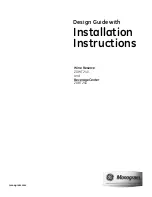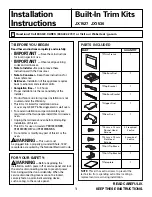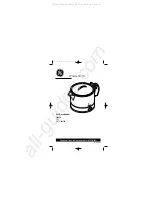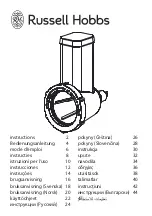
11
GB
O R I G I N A L I N S T R U C T I O N S
Depending on the installed cooking plates, the appliance allows toasting toasts prepared from toasted bread, baking wa
ffl
es or
roasting food products on the cooking plate.
Heat up the cooking plates before toasting. To do this, close the sandwich maker lid and secure it with the latch (II). Plug the power
cord plug into the socket. The power indicator light will come on and the cooking plates will start to heat up. The end of the heating
process will be indicated by the ready indicator light going out. Carefully lift the lid and place the products to be heated between
the plates. Do not place the toasts on top of each other, lay them on the surface of the plate. Close the lid and secure it with the
latch. The power indicator light will go out and the toasting will start. When the toasting is
fi
nished, the power indicator light will go
out again. Lift the lid carefully and remove the prepared products from the cooking plate.
Depending on the number of products placed on the cooking plate, the toasting time will vary. The more products the longer the
toasting time.
The appliance can be switched o
ff
at any time by unplugging the power cord plug from the socket. Do not leave the appliance
unattended during operation. When the indicator light comes on, the appliance will not switch o
ff
automatically and will start to heat
up again after a while. Leaving the appliance unattended with toasts between the cooking plates can lead to
fi
re.
WARNING! Special care should be taken when opening the heated lid. Use gloves which protect against high temperatures.
It is possible to replace the sandwich maker’s cooking plates. Always replace the plates in pairs, top and bottom.
Before replacing, make sure that the plates in the sandwich maker and the replacement plates are not hot, dirty, wet or damp.
Open the sandwich maker lid, pull both locking levers simultaneously so that the spring lifts the cooking plate (III). Mount the plate
so that the longer tabs on the edge of the plate
fi
rst hit the openings of the sandwich maker’s casing (IV). The openings are located
on the opposite side of the locking lever. Then press the other edge of the plate so that both locks secure it in the sandwich mak-
er’s casing. A correctly installed cooking plate cannot be removed otherwise than by pulling back both lock levers.
After the ribbed cooking plates have been installed, the lid can be opened by 180 degrees and the sandwich maker can be used
as a table grill. To open the cover completely,
fi
rst open the cover by 90 degrees, then lift it slightly and continue to open (V). After
opening, both plates heat up independently, which is indicated by lights.
The ribbed cooking plates are equipped with a hole for removing excess fat. The lid and base are equipped with holes for fat re-
moval. The hole in the lid has a plug. The plug must be opened (VI) and then use the opened lid to support the opened lid against
surface. Otherwise it will not be possible to place the lid parallel to the surface. Place a container under each of the holes to collect
the excess fat. The container should be made of a non-
fl
ammable and high-temperature-resistant material.
The cooktop heats up to a high temperature, contact with unprotected body can lead to serious burns. When preparing food, care
should be taken not to touch the cooktop, and the cooked food should checked using appropriate utensils, e.g. pliers or paddles
made of plastic or wood.
When selecting utensils, it is important to take into account whether they can withstand the temperature generated by the cooktop.
Do not use metal utensils or utensils with sharp edges. Such utensils can damage the cooktop surface.
Appliance maintenance
CAUTION!
All maintenance must be carried out with the appliance switched o
ff
.
To do this, unplug the power cord from the
socket.
The appliance is used to prepare food placed directly on the cooktop, therefore care must be taken to maintain proper hygiene so
that the preparation of food is safe.
The cooktop can be protected with a preservative agent for transport and storage. Before
fi
rst use, after cleaning, heat the cooktop
to its maximum temperature and allow all residues of the preservative agent to evaporate. The evaporating preservative agent can
cause smoke, which is a normal phenomenon. Therefore, evaporation should be carried out in a place with e
ffi
cient ventilation. Do
not inhale the vapours of the preservative agent.
After the evaporation is
fi
nished and the smoke stops
fl
owing, disconnect the appliance from the power supply, wait until the
cooktop cools down completely and clean it again with a cleaning agent. Only then can the cooktop be used for food preparation.
Clean the cooktop and other parts of the appliance with a cloth soaked in a water solution of a mild dishwashing detergent.
Remove any residues of the solution with a cloth soaked in water. After cleaning, wipe the appliance dry. The cooktop should
be cleaned after each use, once it cooled down completely. Clean any food residue remaining on the cooktop to prevent it from
burning when used again, and to prevent the machine’s performance from being impaired.
Do not use solvents, caustics, alcohol, petrol or abrasives for cleaning.
Clean the ventilation openings with a vacuum cleaner.
Caution! Never immerse the appliance in water or any other liquid.
The drip trays should be removed from the unit and cleaned with dishwashing liquid under running water or in a dishwasher.
If the appliance has removable cooking plates, they must be removed and cleaned with a dishwashing liquid under running water
stream. Do not use abrasive cleaning agents to clean cooking plates. Do not wash the cooking plates in a dishwasher or with a
high-pressure water jet.
Summary of Contents for 67522
Page 17: ...17 RUS 8 10...
Page 18: ...18 RUS 10O C 38O C 90 16...
Page 19: ...19 RUS II III IV 180 90 V VI...
Page 20: ...20 RUS 67522 220 240 50 60 1100 1300 I 260 x 220 2 75...
Page 21: ...21 UA 8 10...
Page 22: ...22 UA 10 O C 38 O C 90 16...
Page 23: ...23 UA II III IV 180 90 V VI...
Page 24: ...24 UA 67522 220 240 50 60 1100 1300 I 260 x 220 2 75...
Page 65: ...65 GR 8 10 cm...
Page 66: ...66 GR 10 O C 38 O C 90 16 A...
Page 67: ...67 GR II III IV 180 90 V VI...
Page 68: ...68 GR 67522 V 220 240 Hz 50 60 W 1100 1300 I mm 260 x 220 kg 2 75...












































